

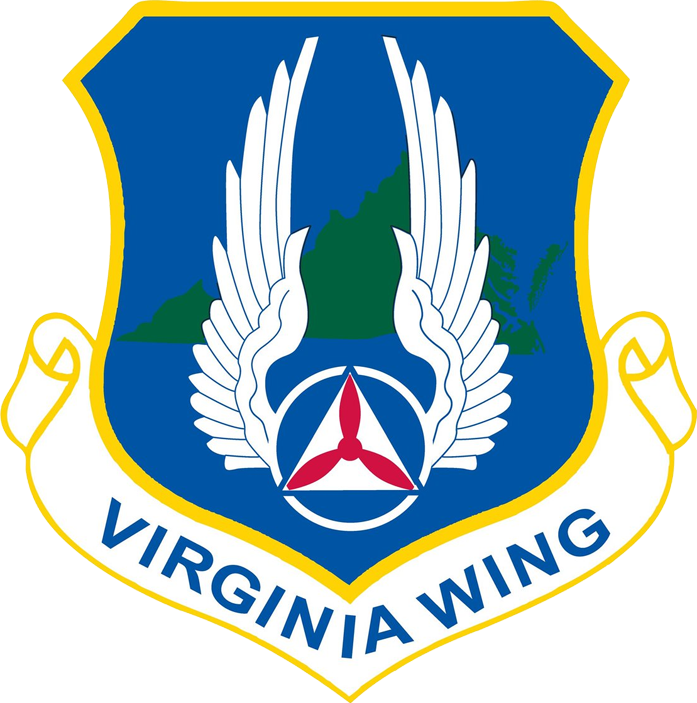
Taken from a press release:
"The 2,000 members of Civil Air Patrolís (CAP) Virginia Wing (VAWG) can now proudly wear a new patch on their sleeves. Colonel Dean Gould, the wingís commander, announced the final approved patch last night. All members have five years to transition their uniforms to the new patch."
"Col. Gould, who assumed command of VAWG in 2017, endeavored that during his command the patch would be updated. He commented, "It was important to keep our historical past in our patch, so with the new patch we adjusted it to the updated United States Air Force shield format which is similar to headquarters patches across the Air Force." The patch focuses on VAWGís primary mission of serving the Commonwealth of Virginia with the outline of the state on the patch. The colors match the same red and blue colors used across all of CAP. The shield format represents an organization that is flag bearing of which 22 different units fall under the command of VAWG. The outgoing patch dates back to the wingís first commander and is a key symbol of VAWG which is quickly recognizable and used in nearly all publications, websites, and social media related to the wing."
Information provided by:
Excerpt from a VAWG press release
March 24, 2021


"It was designed by Cadet Airman Nathan Watkins of our squadron. I am the Squadron Commander for the unit and Colonel David Carter is the Wing Commander who approved the patch in June of this year."
"Iím told the "Black sheep" moniker dates back to the early 1970ís when the squadron, unable to gain financing through CAP, bought a aircraft with their own funds. They painted it in the CAP color scheme and promptly bent the plane so it was no longer usable. No one was injured, thankfully. Because the squadron went outside the norm to source the aircraft they became known as the Black Sheep squadron."
"In honor of those CAP members who helped (unintentionally) find a name for the squadron we have placed a black sheep at the center of our tri-prop. The tri-prop represents the CAPís three core missions, Cadet Programs, Aerospace Education and Emergency Services. The spinning prop represents our constant motion to improve ourselves and the communities in which we live."
Information provided by:
Capt Christopher Colvin, Commander
October 28, 2010

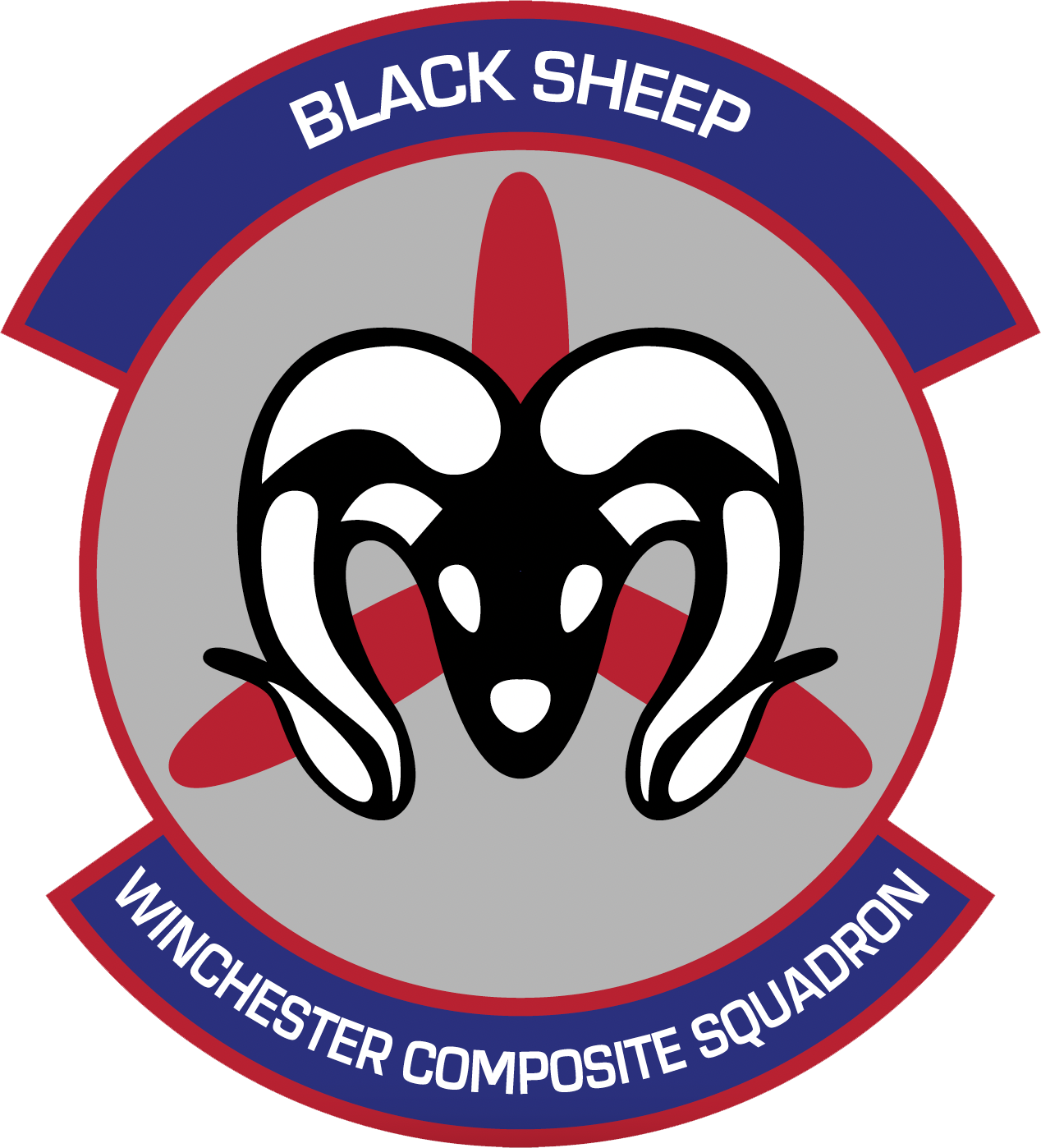
Motto: "Black Sheep"
Colors: Pimento Red (Pantone 200 C), Ultramarine Blue (Pantone Reflex Blue C), Silver Gray (Pantone 422 C).
Statement of Significance: The emblem's colors of red, blue, and grey are utilized to be easily identifiable as a Civil Air Patrol organization. The emblem also maintains the red tri-blade element having been a unit for as many years as Civil Air Patrol has been easily identified by this element and the unit's continued commitment to all three main missions.
The black sheep motto was adopted at a time in the unit's history when the squadron was known for its independent and unique initiatives. Given Winchester's geography, the unit used to fly more search and rescue missions for WV & MD instead of VA due to proximity to those states. The black sheep name and logo is now a bridge to the squadron's unique and storied past that included countless rescue finds and manhours spent on search and rescue missions in the Blue Ridge Mountains. The unit's members' fearless drive to serve (and save) others ensured the mission was always the priority, regardless of state lines and territories.
The squadron has become a premier location in the wing for aircraft utilization, radio communications, and mission support. It has a positive presence in the local community, being a member of the chamber of commerce, and is a role model of Civil Air Patrol's mission statement and continuously demonstrating the organization's core values. The black sheep is retained on the emblem as a reminder of how far they have come and harken back to the squadron's founding and early years.
Information provided by:
Lt Col Matthew Creese
April 1, 2025

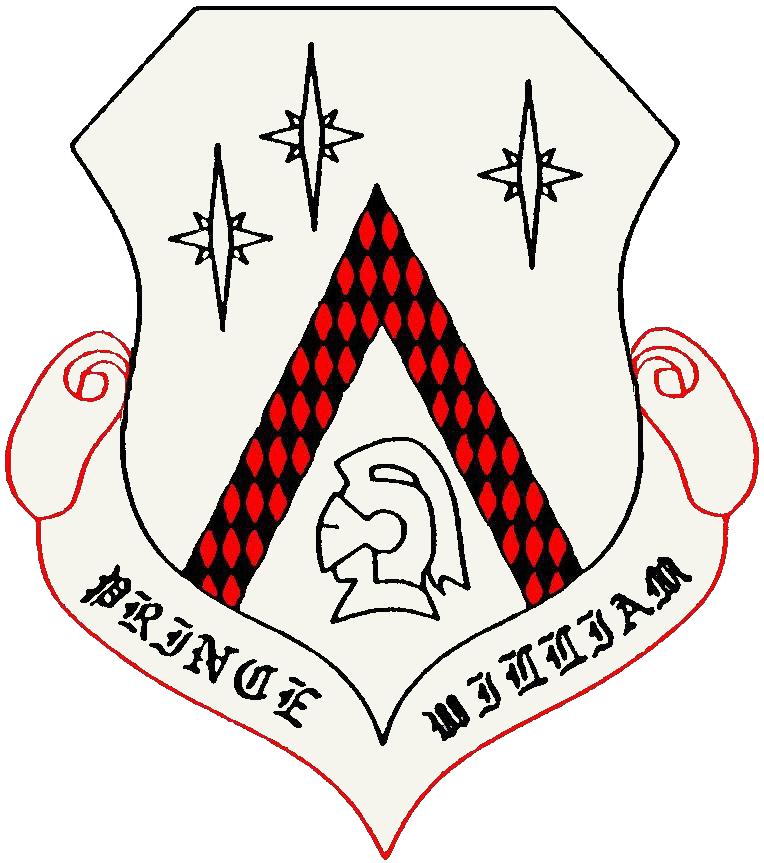 The essential design of the Prince William Composite Squadron crest emulates a royal coat of arms. Adopting this style pays tribute to the unit's namesake, Prince William, the Duke of Cumberland (1721-1765) and to the county in Virginia named for him which is the unit's home. The depiction of a knight's helmet in the lower sector of the crest reminds us of a heritage of chivalry.
The essential design of the Prince William Composite Squadron crest emulates a royal coat of arms. Adopting this style pays tribute to the unit's namesake, Prince William, the Duke of Cumberland (1721-1765) and to the county in Virginia named for him which is the unit's home. The depiction of a knight's helmet in the lower sector of the crest reminds us of a heritage of chivalry.
The central feature of the crest is the chevron. Deviding the crest into sectors, it resembles an arrow pointing skyward, and symbolizes the unit's continuing efforts toward betterment. The checkered pattern of the chevron is reminiscent of the checkered flag marking the end of a race for a triumphant competitor. As a competitive spirit is the cornerstone of Prince William's strategy for achievement, this pattern is very significant.
Three start adorn the upper sector of the crest. These, of course, symbolize the three missions of Civil Air Patrol: Aerospace Education, the Cadet Program, and Emergency Services. The combination of the chevron and the stars captures the essence of the unit's adopted motto: "Ad Astra Per Aspera". Translated from Latin, this means: "To The Stars We Aspire". Our motto indicates the high standards expected of Prince William's members.
The stars also reflect Prince William's commitment to excellence in all three endeavors. They are patterned after the ancient mariner's compass rose in the hope that we may never lose our way in the arduous journey toward these lofty goals.
The squadron crest was designed by former Squadron Commander, Lt Col B.T. Marking, and was approved for use as a squadron patch by the Virginia Wing uniform committee on May 5, 1989."
Information provided by:
1st Lt Al Jaques
January 1996

In June 2013, Virginia Wing Commander Col Jim Covel approved the squadron patch and emblem design for Prince William Composite Squadron. The new emblem brings forward our squadron motto: To The Stars.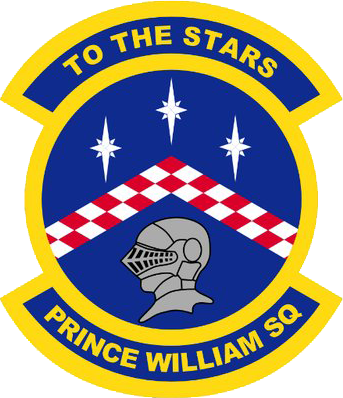
The emblem's design revives the heraldry of the [Version 2] patch approved by the Wing in 1989. This patch was designed by Lt Col B.T. Marking, who was the squadron commander at the time.
The essential design of the Prince William Composite Squadron crest emulates a royal coat of arms and is derived heavily from our previously approved crest, updated to reflect current USAF patch guidance. Adopting this style pays tribute to the unitís namesake, Prince William, the Duke of Cumberland (1721-1765), and to the county in Virginia named for him which is the unitís home.
The depiction of a knightís helmet in the lower sector of the crest reminds us of a heritage of chivalry.
The central feature of the crest is the chevron. Dividing the crest into sectors, it resembles an arrow pointing skyward and symbolizes the unitís continuing efforts toward betterment. The checkered pattern of the chevron is reminiscent of the checkered flag marking the end of a race for a triumphant competitor. As a competitive spirit is the cornerstone of Prince Williamís strategy for achievement, this pattern is very significant.
Three stars adorn the upper sector of the crest. These, of course, symbolize the three missions of Civil Air Patrol: Aerospace Education, the Cadet Program, and Emergency Services. The combination of the chevron and the stars captures the essence of the unitís adopted motto: "Ad Astra Per Aspera." Translated from Latin, this means: "To The Stars We Aspire." Shortened and translated from Latin, our motto "To The Stars" indicates the high standards expected of Prince Williamís members.
The stars also reflect Prince Williamís commitment to excellence in all three endeavors. They are patterned after the ancient marinerís compass rose in the hope that we may never lose our way in the arduous journey toward these lofty goals.
The original squadron crest was based on an orange and gray color scheme. The current colors of the patch are inherited from the Civil Air Patrol emblem and USAF colors. Blue signifies the sky, which is the primary theater for Air Force operations as well as Civil Air Patrolís underpinning aerospace orientation. Yellow signifies the excellence that is expected of all Civil Air Patrol personnel. The red and white of the chevron signify the boldness and truthfulness which marks our membersí pursuit of excellence.
Information provided by:
Prince William Composite Squadron
April 18, 2025

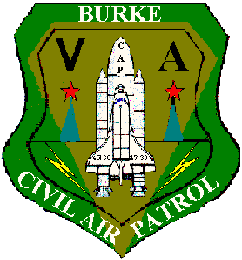
Information provided by:
Burke Composite Squadron

HERALDRY OF VA-140 SQUADRON INSIGNIA
SHAPE: A disc-shaped field with upper and lower rockers
DESCRIPTION: Within the field, a Cessna 172 flies over the Norris Bridge and the Rappahannock River valley at sunrise, with the aircraft, the bridge, and hills in the background silhouetted by the morning sun. The text "CIVIL AIR PATROL" is located in the upper rocker, the text "HUMMEL FIELD COMPOSITE SQUADRON" is located in the lower rocker, and the text "VA 140" is located at the bottom of the field.
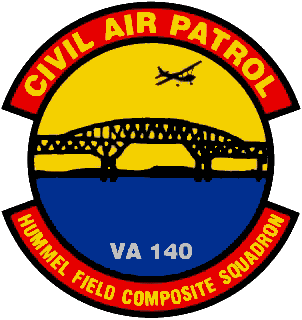 SYMBOLISM OF DESIGN ELEMENTS:
SYMBOLISM OF DESIGN ELEMENTS:
(a) Cessna 172: This aircraft type is most commonly used during flight operations by the squadron, and is representative of both senior squadron members, who fly the 172 in Emergency Services missions, and cadet squadron members, who learn about aviation through orientation flights in the 172.
(b) Norris Bridge and Rappahannock River: The Norris Bridge is less than one mile from Hummel Field, where VA 140 Is located, and is symbolic of the Middle Peninsula and Northern Neck regions of Virginia, which squadron members are proud to call home. The bridge also brings together two areas which were geographically isolated prior to its construction, in much the same way that squadron members serving as civilians within the auxiliary of the United States Air Force serve as a virtual Ďbridgeí between the civilian members of our community and the military that exists to protect and defend them.
SYMBOLISM OF DESIGN COLORS:
(a) Upper and lower rockers: The upper and lower rockers are red, which is symbolic of Civil Air Patrol as a whole. Red is the central color of the CAP emblem, where it is found as a red three-bladed propeller which itself is symbolic of the three primary missions of CAP -- Cadet Programs, Aerospace Education, and Emergency Services.
(b) Morning sky and all text except "VA 140": The morning sky and the text "CIVIL AIR PATROL" and "HUMMEL FIELD COMPOSITE SQUADRON" are gold in color. This color symbolizes excellence, and reminds every squadron member that our goal as Civil Air Patrol members should be to excel in all our activities.
(c) Rappahannock River: The river shall, as nearly as possible, be rendered in the following shade of blue -- Pantone 287 or CMYK (Cyan 100, Magenta 69, Yellow 01, Black 11.5) or RGB (Red 0, Green 48, Blue 143). This is the official color for display of the Unites States Air Force Symbol when it is displayed in blue. This color, and the color of the text "VA 140" (see below) together are symbolic of the United States Air Force, of which the Hummel Field Composite Squadron is a part.
(d) Text "VA 140": This text shall, as nearly as possible, be rendered in the following shade of grey -- Pantone Cool Grey 7 or CMYK (Cyan 0, Magenta 0, Yellow 0, Black 50) or RGB (Red 166, Green 166, Blue 168). This is the official color for display of the United States Air Force Symbol when it is displayed in grey, and is also symbolic of the Air Force.
(e) Norris Bridge and Cessna 172: The bridge and aircraft are black. Black is the absence of color. This serves to remind squadron members that the outcome of our endeavors is up to us. The absence of color of the aircraft and bridge, as well as the hills in the background, symbolizes the fact that, on the ground and in the air, our actions will ultimately Ďfill iní the result.
The patch was designed by squadron member, 2d Lt Robert C Moyer. The Deputy Squadron Commander, Lt Col Bert Jones, accepted the design on behalf of the Squadron Commander, Maj Francis Bernhardt, while he was away on a medical absence. Col Eric R Litt, Virginia Wing Commander, approved the design for wear in November 2008
Information provided by:
2d Lt Robert C Moyer, VA-140
January 13, 2009